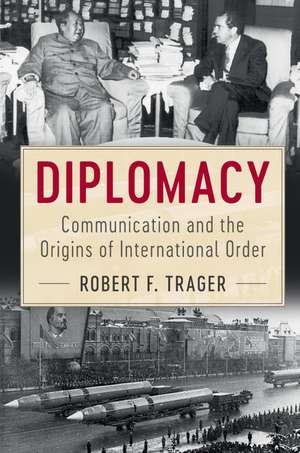Diplomacy: Communication and the Origins of International Order
Autor Robert F. Trageren Limba Engleză Paperback – 25 oct 2017
| Toate formatele și edițiile | Preț | Express |
|---|---|---|
| Paperback (1) | 286.13 lei 6-8 săpt. | |
| Cambridge University Press – 25 oct 2017 | 286.13 lei 6-8 săpt. | |
| Hardback (1) | 555.17 lei 6-8 săpt. | |
| Cambridge University Press – 25 oct 2017 | 555.17 lei 6-8 săpt. |
Preț: 286.13 lei
Nou
Puncte Express: 429
Preț estimativ în valută:
54.75€ • 57.32$ • 45.30£
54.75€ • 57.32$ • 45.30£
Carte tipărită la comandă
Livrare economică 05-19 aprilie
Preluare comenzi: 021 569.72.76
Specificații
ISBN-13: 9781107627123
ISBN-10: 1107627125
Pagini: 318
Ilustrații: 33 b/w illus. 8 tables
Dimensiuni: 152 x 226 x 16 mm
Greutate: 0.41 kg
Editura: Cambridge University Press
Colecția Cambridge University Press
Locul publicării:New York, United States
ISBN-10: 1107627125
Pagini: 318
Ilustrații: 33 b/w illus. 8 tables
Dimensiuni: 152 x 226 x 16 mm
Greutate: 0.41 kg
Editura: Cambridge University Press
Colecția Cambridge University Press
Locul publicării:New York, United States
Cuprins
1. Can adversaries communicate?; 2. How perceptions of intentions form; Part I. Theory: 3. The scope of demands; 4. Risking a breach; 5. Balancing allies and adversaries; 6. Diplomatic approaches; Part II. Empirical Analysis: 7. The fruit of 1912 diplomacy; 8. How Germany weighed British resolve in 1938–9; 9. Statistical analysis of diplomatic communication; 10. Creating international orders; Appendices: A. Proofs for chapters 3-6; B. Inference data set; C. Threats, offers, and assurance dataset; D. German inferences prior to World War II.
Recenzii
'All in all, this book is much more than just a welcome addition to the literature on the study of diplomacy, since it successfully breaks new methodological ground and manages to gracefully combine history with political science research and methods, while also contributing to historical debates on seminal diplomatic incidents.' Alexandros Nafpliotis, Diplomatica
Notă biografică
Descriere
This book explores questions such as: How do adversaries communicate? How do diplomatic encounters shape international orders and determine whether states go to war?

